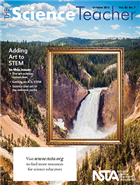Science 2.0: Students as Empowered Learners
By sstuckey
Posted on 2016-10-15
In the September issue of The Science Teacher, we wrote about the new standards for digital skills established by the International Society for Technology in Education (ISTE). Now, let’s look at how the standards can be applied to science content.
This month, we discuss the Empowered Learner standard, which requires that “students leverage technology to take an active role in choosing, achieving, and demonstrating competency in their learning goals, informed by the learning sciences.” To accomplish this standard, students should meet these four performance indicators:
- Engage in personal goal setting that includes reflection,
- Develop the ability to build a network to support their learning,
- Use technology to receive feedback in different forms, and
- Understand and troubleshoot technology.
Meeting the performance indicators
Goal-setting is a critical part of the learning process. SMART Goal templates, often used in business, can ensure that students are developing personal goals. Students can use blogs (e.g., WordPress), journaling tools (e.g., Evernote), or even “media diaries” (e.g., Fotobabble and Photo 365) to share their thoughts or reflect on their goal achievement and learning. Changes to thoughts or understanding can also be seen through the evolution of student writing via track changes in Microsoft Word or revision history in Google Docs.
To become an empowered learner, students must build a network to enhance their learning. Twitter can be a powerful tool to build and grow learning spheres. Point your students in the right direction by creating a class account used to follow science-related people and groups. When starting your Twitter network, consider following NASA (@nasa), Earth Science Week (@earthsciweek), NSF Earth Science
(@NSF_EAR), and Neil DeGrasse Tyson (@neiltyson). After establishing the classroom’s virtual networks, allow students to customize their learning environment with flexible and moveable classroom arrangements, such as furniture, which foster a collaborative and “networked” classroom.
Empowered learners should be familiar with the feedback many technology tools inherently provide. It is important that students recognize the value of “adaptive learning tools,” such as Knewton, as a means to grow and develop in any content area. It is equally important that students draw upon technology tools’ interaction and peer feedback capabilities found in resources such as Google Docs, VoiceThread, or Padlet. With those commenting tools, students can share thoughts about the instruction, conclusions drawn from a lab investigation, or predictions about a future event, while quickly receiving comments from other students, teachers, or experts in the field. No matter the tool, however, gathering peer feedback develops the communication skills necessary for the requirements of this standard.
None of the performance indicators are possible without a basic understanding of how technology tools work, so that technology never serves as a barrier or distraction to learning. To illustrate the supportive nature of technology and understanding how the tools fundamentally work, use Chrome Extensions with students. Students must understand that the Chrome browser is a power productivity tool that can be enhanced by Extensions and Apps to improve learning, perform tasks, and enhance their work. As an example, head over to the Chrome Web Store and search for the “periodic table.” You will quickly find both apps and extensions that can be valuable for students.
Conclusion
The Empowered Learner standard allows students to develop an independence and responsibility for their learning. As students mature and advance their skills in this area, they will be ready to tackle the rest of the standards. In the next issue, we will examine the role that digital citizenship plays and the responsibility that all educators have to foster it in their classrooms.
Ben Smith (ben@edtechinnovators.com) is an educational technology program specialist, and Jared Mader (jared@edtechinnovators.com) is the director of technology, for the Lincoln Intermediate Unit in New Oxford, Pennsylvania. They conduct teacher workshops on technology in the classroom nationwide.
Editor’s Note
This article was originally published in the October 2016 issue of The Science Teacher journal from the National Science Teachers Association (NSTA).
Get Involved With NSTA!
Join NSTA today and receive The Science Teacher,  the peer-reviewed journal just for high school teachers; to write for the journal, see our Author Guidelines and Call for Papers; connect on the high school level science teaching list (members can sign up on the list server); or consider joining your peers at future NSTA conferences.
the peer-reviewed journal just for high school teachers; to write for the journal, see our Author Guidelines and Call for Papers; connect on the high school level science teaching list (members can sign up on the list server); or consider joining your peers at future NSTA conferences.
The mission of NSTA is to promote excellence and innovation in science teaching and learning for all. Learn more about the Next Generation Science Standards at the NGSS@NSTA Hub.
Future NSTA Conferences
2016 Area Conferences
Disclaimer: The views expressed in this blog post are those of the author(s) and do not necessarily reflect the official position of the National Science Teaching Association (NSTA).

